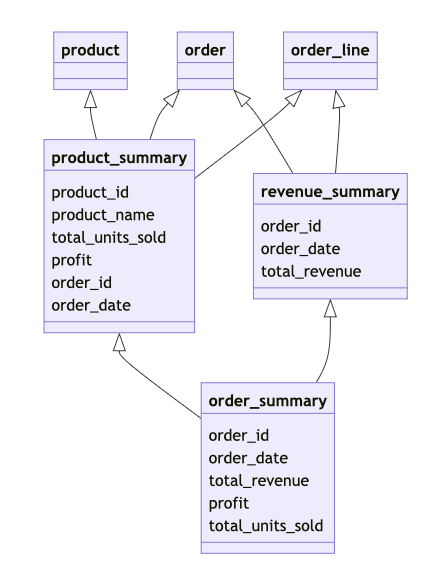Tutorial
Use SELECT statements to create insights from the data in the database.
Prerequisites
Make sure you run the Load step first to get the data in the database.
The insights
In this tutorial, we will create 3 insights:
- revenue_summary: to get the total revenue per order
- product_summary: to get per product and order, the total revenue, the number of units sold and the profit
- order_summary: to get per order, the total revenue, the profit and the number of items sold
This requires us to build the insights in the following order:
- revenue_summary and product_summary
- order_summary

The SELECT statements
We will store these insights in the kpi schema. We need to write one SQL query per insight as shown below:
SELECT
o.order_id,
o.timestamp AS order_date,
SUM(ol.quantity * ol.sale_price) AS total_revenue
FROM
starbake.order o
JOIN starbake.order_line ol ON o.order_id = ol.order_id
GROUP BY
o.order_id, o.timestamp
SELECT
p.product_id,
p.name AS product_name,
SUM(ol.quantity) AS total_units_sold,
(SUM(ol.sale_price) - Sum(ol.quantity * p.cost)) AS profit,
o.order_id,
o.timestamp AS order_date
FROM
starbake.product p
JOIN starbake.order_line ol ON p.product_id = ol.product_id
JOIN starbake.order o ON ol.order_id = o.order_id
GROUP BY
p.product_id,
o.order_id, p.name, o.timestamp
SELECT
ps.order_id,
ps.order_date,
rs.total_revenue,
ps.profit,
ps.total_units_sold
FROM
kpi.product_summary ps
JOIN kpi.revenue_summary rs ON ps.order_id = rs.order_id
Storing the sql files in the kpi directory instructs starlake to store the insights in the kpi schema.
Your metadata/transform directory should look like this:
metadata/transform
└── kpi
├── order_summary.sql
├── product_summary.sql
└── revenue_summary.sql
Run the transform
before running our transform, let's see in what order we should run them by running the following command:
starlake lineage --task kpi.order_summary --print
This should produce a acyclic graph showing the order in which the insights should be run. The output should look like this:
kpi.order_summary
kpi.product_summary
starbake.product
starbake.order_line
starbake.order
kpi.revenue_summary
starbake.order
starbake.order_line
If you installed the GraphViz tool, you can produce the same graph in svg or png format using the following command:
starlake lineage --task kpi.order_summary --svg --output lineage.svg
To build our top level insight, we can run the following command using the recursive flag, this instructs starlake to run the insights in the correct order:
starlake transform --recursive --name kpi.order_summary
Our database should now contain the following tables and data (amounts and dates may differ here):
$ duckdb $SL_ROOT/datasets/duckdb.db
v0.10.0 20b1486d11
Enter ".help" for usage hints.
D show;
┌──────────┬──────────┬─────────────────┬──────────────────────┬───────────────────────────────────────────────────────────────────────────────────────────────────┬───────────┐
│ database │ schema │ name │ column_names │ column_types │ temporary │
│ varchar │ varchar │ varchar │ varchar[] │ varchar[] │ boolean │
├──────────┼──────────┼─────────────────┼──────────────────────┼───────────────────────────────────────────────────────────────────────────────────────────────────┼───────────┤
│ duckdb │ audit │ audit │ [JOBID, PATHS, DOM… │ [VARCHAR, VARCHAR, VARCHAR, VARCHAR, BOOLEAN, BIGINT, BIGINT, BIGINT, TIMESTAMP, INTEGER, VARCH… │ false │
│ duckdb │ audit │ rejected │ [JOBID, TIMESTAMP,… │ [VARCHAR, TIMESTAMP, VARCHAR, VARCHAR, VARCHAR, VARCHAR] │ false │
│ duckdb │ kpi │ order_summary │ [order_id, order_d… │ [BIGINT, TIMESTAMP, DOUBLE, DOUBLE, HUGEINT] │ false │
│ duckdb │ kpi │ product_summary │ [product_id, produ… │ [BIGINT, VARCHAR, HUGEINT, DOUBLE, BIGINT, TIMESTAMP] │ false │
│ duckdb │ kpi │ revenue_summary │ [order_id, order_d… │ [BIGINT, TIMESTAMP, DOUBLE] │ false │
│ duckdb │ starbake │ order │ [customer_id, orde… │ [BIGINT, BIGINT, VARCHAR, TIMESTAMP] │ false │
│ duckdb │ starbake │ order_line │ [order_id, product… │ [BIGINT, BIGINT, BIGINT, DOUBLE] │ false │
│ duckdb │ starbake │ product │ [category, cost, d… │ [VARCHAR, DOUBLE, VARCHAR, VARCHAR, DOUBLE, BIGINT] │ false │
└──────────┴──────────┴─────────────────┴──────────────────────┴───────────────────────────────────────────────────────────────────────────────────────────────────┴───────────┘
D select * from kpi.order_summary limit 5;
┌──────────┬─────────────────────────┬────────────────────┬─────────────────────┬──────────────────┐
│ order_id │ order_date │ total_revenue │ profit │ total_units_sold │
│ int64 │ timestamp │ double │ double │ int128 │
├──────────┼─────────────────────────┼────────────────────┼─────────────────────┼─────────��─────────┤
│ 24 │ 2024-02-13 07:03:35.94 │ 11708.55 │ 7609.14 │ 405 │
│ 27 │ 2024-02-26 01:12:45.282 │ 2430.00 │ 850.50 │ 162 │
│ 44 │ 2024-03-01 04:48:42.158 │ 2109.24 │ 1090.26 │ 243 │
│ 46 │ 2024-02-10 18:27:05.732 │ 3645.00 │ 1883.25 │ 243 │
│ 56 │ 2024-01-30 07:33:08.621 │ 6075.00 │ 3948.75 │ 405 │
└──────────┴─────────────────────────┴────────────────────┴─────────────────────┴──────────────────┘
D .quit
Our insight is now built and stored in the kpi schema. We can now run them from inside our orchestrator to schedule them to run at regular intervals.